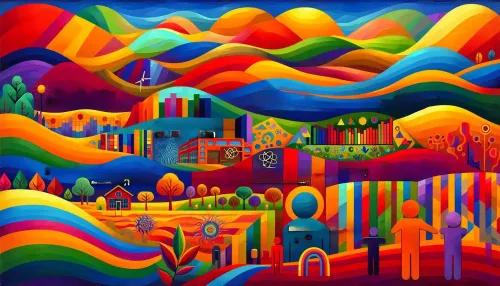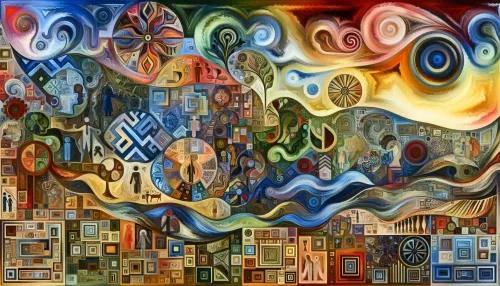
Celebrating Diversity: Exploring the Impact of Cultural Heritage on Autism Understanding and Support

Autism is a complex neurodevelopmental condition that affects individuals worldwide, transcending cultural boundaries. The perception and support for autistic children vary greatly across diverse cultures, influenced by unique traditions, beliefs, and societal structures. In this article, we delve into the rich tapestry of cultural heritage and its profound impact on understanding and supporting autistic children. Let's embark on a journey that celebrates diversity while shedding light on the invaluable insights gleaned from different cultural perspectives.
Bridging Worlds: A Deep Dive into How Diverse Cultures Perceive and Support Autism
Every culture weaves a distinct narrative around autism, shaping perceptions and fostering unique support systems. In some cultures, autism is viewed through a mystical lens, often associated with spiritual or supernatural explanations. Contrarily, modern Western societies approach autism from a clinical standpoint, emphasizing diagnostic categorization and therapeutic interventions.
This dichotomy underscores the need for a holistic understanding of autism that incorporates diverse cultural viewpoints. By acknowledging cultural variations in perceiving autism, we can bridge worlds, cultivate empathy, and foster inclusive support mechanisms that resonate with diverse communities.
Unveiling Hidden Strengths: The Role of Indigenous Knowledge in Nurturing Autistic Children
Indigenous cultures possess centuries-old wisdom that transcends conventional knowledge. These rich traditions often harbor profound insights into nurturing autistic children, leveraging indigenous practices to harness their hidden strengths. Traditional healing methods, communal upbringing, and spiritual rituals embedded within indigenous knowledge systems can offer alternative avenues for supporting autistic children, complementing contemporary approaches with a deeper understanding of cultural nuances.
By celebrating indigenous knowledge in autism care, we honor the resilience and resourcefulness of different cultures while amplifying the voices of marginalized communities within the broader discourse on autism support.
Family Ties: The Importance of Extended Family Structures in Autism Care Across Different Societies
The fabric of family dynamics varies significantly across cultures, influencing the caregiving landscape for autistic children. In many cultures, extended family structures play a pivotal role in providing comprehensive support to autistic individuals. Grandparents, aunts, uncles, and cousins often contribute to caregiving responsibilities, fostering a network of holistic care that extends beyond immediate nuclear families.
Understanding the centrality of extended family ties in autism care empowers us to tailor support systems that align with diverse familial structures, promoting collaborative caregiving models anchored in cultural kinship traditions.
Language and Expression: Understanding Autism Communication Strategies in Multilingual Contexts
In multilingual societies, the intersection of language diversity and autism communication strategies presents a compelling tapestry of challenges and opportunities. Autistic children who grow up in multilingual environments navigate distinct linguistic landscapes, each carrying its own set of communication norms and nuances.
By unraveling the intricacies of language and expression in the context of autism across diverse linguistic backgrounds, we pave the way for culturally responsive communication interventions that honor linguistic diversity while optimizing supportive interactions for autistic children.
Rituals and Rhythms: The Therapeutic Potential of Cultural Traditions for Autistic Children
Cultural traditions encompass a spectrum of rituals and rhythms that hold profound therapeutic potential for autistic children. From rhythmic drumming ceremonies to traditional dance forms, many cultural practices intertwine sensory stimuli with communal participation, offering avenues for sensory integration and emotional expression tailored to the needs of autistic individuals.
Acknowledging the therapeutic value embedded within cultural traditions empowers us to incorporate culturally relevant interventions that resonate with autistic children, enriching their developmental journey through meaningful engagements with their cultural heritage.
From Taboo to Acceptance: Tracing the Evolution of Autism Perception in Various Cultures
The evolution of autism perception echoes the broader societal shifts witnessed across different cultures. In some cultures, autism was historically shrouded in misconceptions or stigmatization, relegating autistic individuals to the margins of society. Over time, advocacy efforts have paved the way for increased awareness, transforming erstwhile taboos into narratives of acceptance and inclusion.
By tracing this evolutionary trajectory, we gain invaluable insights into the strides made within diverse cultural contexts as they embrace neurodiversity and champion the rights of autistic individuals within their communities.
Collective Wisdom: How Community Beliefs Shape Autism Interventions and Outcomes
Communities serve as crucibles of collective wisdom, shaping autism interventions and influencing outcomes based on deeply ingrained beliefs. By examining community-specific beliefs surrounding autism, we unravel the intricate interplay between cultural norms, community support structures, and prevailing attitudes toward neurodiversity.
Harnessing this collective wisdom empowers us to forge collaborative partnerships with communities, co-creating culturally sensitive intervention frameworks that align with community beliefs while nurturing an ethos of solidarity and inclusivity for autistic individuals.
Embracing Neurodiversity: Lessons from Cultures Around the World
Embracing neurodiversity necessitates drawing inspiration from cultures around the world that demonstrate a reverent embrace of diversity in all its forms. By highlighting exemplary practices from diverse cultural milieus that celebrate neurodiversity, we glean valuable lessons that transcend geographical boundaries, enriching our understanding of inclusive practices that honor the unique strengths inherent within every autistic individual.
Socioeconomic Factors: Navigating the Challenges and Opportunities in Global Autism Support
Socioeconomic disparities exert pronounced influences on autism support mechanisms across global contexts. Access to resources, healthcare infrastructure, educational opportunities, and social welfare provisions varies widely among different societies. Recognizing these disparities prompts us to formulate nuanced strategies that address socioeconomic barriers while harnessing existing strengths within diverse socioeconomic landscapes to foster equitable support for autistic children worldwide.


